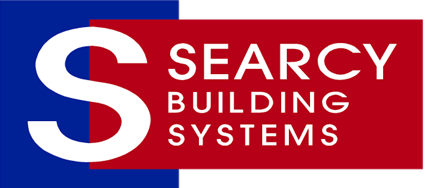Understanding the Anatomy of Metal Buildings
Core Components
Standard prefabricated steel buildings are comprised of several different components, designed and detailed to be pre-cut, pre-welded, and pre-drilled. This is a key benefit of pre-engineered steel buildings and leaves little room for quality and/or assembly issues. We are primarily a metal building supply company, but we also provide the highest quality components as either individual or replacement materials. Searcy Building Systems can help you understand all of the core components of your steel building.

Primary
Framing
Components
Standard prefabricated steel buildings are comprised of several different components, designed and detailed to be pre-cut, pre-welded, and pre-drilled. This is a key benefit of pre-engineered steel buildings and leaves little room for quality and/or assembly issues. We are primarily a metal building supply company, but we also provide the highest quality components as either individual or replacement materials. Searcy Building Systems can help you understand all of the core components of your steel building.
Frame Types
Interior rigid frames are designed to support half of each of the adjacent bays. Endwall framing is typically a more economical post-and-beam design, intended to support half of the first bay only. Consider a rigid frame expandable endwall if you plan to add on to the building in the future, which will function like an interior rigid frame with the capability to support half of the next bay you add.
Pre-engineered steel buildings can be designed clear span up to 150’ using standard engineering tools. Additional engineering makes it possible for these buildings to be clear span up to 300’ wide. For buildings approximately 80’ or wider, it may be more economical to add load-bearing columns at each interior rigid frame; however, it is important to consider the additional cost for concrete footings at each of these columns.
Your building’s primary framing components can be customized to meet your budget and the needs of your application.

Gabled (Clear Span)
A double-sloped building in which the ridge is in the center of the building. Welded plate, tapered column "clear span" system, available in 1:12 or steeper roof slope.

Gabled (Interior Column)
A double-sloped building in which the ridge is in the center of the building.

Single Sloped
A roof that slopes in one direction with a high sidewall and an opposite low sidewall. Single-slope buildings are typically used for strip malls, office complexes, or buildings along a road frontage. Also commonly used when adding on to an existing building.

Lean-To
Ties in at the eave or below the eave of another building. Unlike the single-slope building, the lean-to does not have high side columns. Instead the rafter attaches to the parent building, which is designed to take the forces of the lean-to.
Secondary
Framing
Components
Depending on the design, these secondary framing components may be required for added structural stability. Pre-welded clips on the primary framing members make it easy to attach your secondary framing. All secondary framing elements are designed Secondary framing components can also be ordered separately for individual or replacement purposes.

Purlins
Purlins run from rafter to rafter in a similar manner as girts but are specifically designed to support roof systems.
Girts
Girts run from column to column around the perimeter of your building. They are installed parallel to the ground, providing support for your wall panels.
Eave Struts
Eave struts are placed at the juncture between your wall and roof, where purlins begin and girts stop.
Steel Building
Bracing Options
Depending on the design, these secondary framing components may be required for added structural stability. Pre-welded clips on the primary framing members make it easy to attach your secondary framing. All secondary framing elements are designed Secondary framing components can also be ordered separately for individual or replacement purposes.

X-bracing
Two steel rods or cables stretch in an “X” shape across your bay. While this is the least expensive bracing option, you cannot install any accessories such as doors or windows in a bay that contains X-bracing.

Wind columns and portal frames:
These options allow you to keep the bay open (able to install a window or door). A wind column may appear to be less expensive, but due to the required concrete for pier footing, it may end up costing more. Be sure to consider this when engineering your bracing design. A metal building distributor will consider the components your application requires and lay out your building in the most cost-effective way.
Steel Building Roof and Wall Panels
Economical & Durable
26-gauge purlin bearing rib (PBR) roof and wall panels are standard on every Searcy Building Systems building. PBR panels lap over the adjacent panels, providing leak protection for a weather-tight building envelope.
We offer several different gauges and profiles for wall and roof panels to achieve a certain look or to meet local building codes. We are also able to quote panels, closure strips, and fastners as individual or replacement materials, to be delivered to your jobsite.


Framed openings for doors and windows
If your building has walk doors, roll-up doors, or windows, you will be supplied the framed openings, full cover trim, and exterior j-trim to give your building a more complete, finished look. Metal building accessories such as personnel doors, roll-up doors, skylights, ridge vents, and windows can be added to your building as needed.
Fasteners
Building drawings and anchor bolt plans
Stamped and certified building and anchor bolt plans are a standard component of pre-engineered metal buildings. Metal building drawings are detailed depictions of your building design and each of its individual components. The anchor bolt plan and building reactions show where to set your bolts within your concrete pad / foundation. It includes the required diameters of the bolts, the projection needed so that the concrete contractor can calculate the overall length of the bolt and the steel reactions depict the forces your building system will have on the slab.
